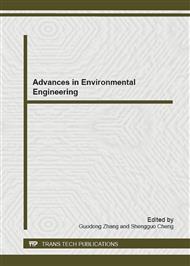p.331
p.335
p.340
p.344
p.348
p.354
p.358
p.363
p.367
Identification of the Pollution Source by Using a Semi-Discretization Approach
Abstract:
This article Considers an inverse problem for identifying a pollution source in a watershed. The pollution concentration is governed by a linear advection-dispersion-reaction equation with a point pollution source modeled by the Dirac function. Firstly, a system of first-order ordinary differential equations is obtained by using the semi-discretization approach and the approximation of the Dirac function. Then the location of the point source is identified from the measurements. Secondly, the numerical scheme is established for recovering the strength of pollution based on the above semi-discretization scheme and the location of the point source. Thirdly, the error analysis was investigated from two aspects: both the semi-discretization and the approximation of the Dirac function. At last, the numerical results show that the presented method is effective.
Info:
Periodical:
Pages:
348-353
Citation:
Online since:
November 2012
Authors:
Price:
Сopyright:
© 2012 Trans Tech Publications Ltd. All Rights Reserved
Share:
Citation:


